Yoshimura History -11
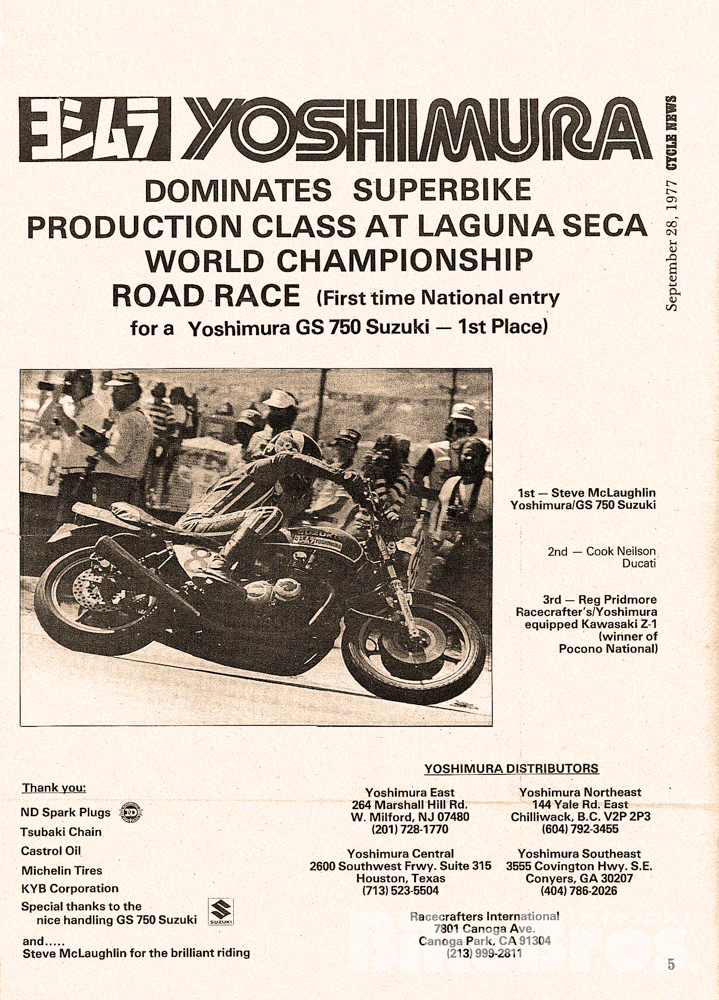
Gratitude to their sponsors, “special thanks” to Suzuki and praise to their rider Steve McLaughlin accompany this advertisement which Yoshimura posted on Cycle News (America’s weekly motorcycle newspaper) to announce the debut win of its GS750/944 at Rd.6 of the 1977 AMA Superbike Championship at Laguna Seca. It also marks the breakthrough for the 4-cylinder bikes, as they have now acquired the chassis to handle the power they produce. Note that the listing of Racecrafters International, which was Yoshimura’s distributor and a racetrack rival at the same time, suggests the fraternal atmosphere of the superbike racing of the era.
Yoshimura History #11: The Birth of Yoshimura Suzuki GS750/944
1976-1977: The Dawn of Yoshimura Suzuki
The partnership between Yoshimura and Suzuki began in August 1976 when Pop met Suzuki engineer Etsuo Yokouchi and had a short conversation, but Pop has already been interested in the new Suzuki.
In the early summer of the same year, while working day and night at Yoshimura R&D America tuning Z1 race bikes and producing 4-into-1 exhaust pipes, Pop saw an engine cutaway drawing in a magazine and immediately drawn into it. It was of the inline 4-cylinder engine of the Suzuki GS series flagship, the GS750.
Since Suzuki had previously been recognized as a 2-stroke vehicle (motorcycles, cars and trucks) manufacturer, they were extra cautious over the market response of the GS series, which was set to be launched initially with GS750 and GS400 in 1976, then with GS550 and GS1000 in 1977. Prior to the debut of their first range of 4-stroke bikes, Suzuki allowed a motorcycle magazine to do a review on the GS750 in order to probe the world’s largest U.S. market. A professional review on a credible American magazine has the potential to decide the global fate (market demand) of a new product, and therefore it was as crucial as the R&D processes such as testing for handling and reliability.
Suzuki’s pick was the Cycle, an American monthly motorcycle publication edited by Cook Neilson who was also racing a Ducati 750SS against Yoshimura and others in AMA Superbike Championship (ranked 4th for 1976 and then 2nd for 1977 season in which he scored his first Daytona victory), as it was known for its fair and accurate criticism. Suzuki invited a Cycle magazine reporter to Japan to test ride a GS750 prototype, and his positive review significantly reinforced Suzuki’s confidence.
Suzuki also provided a GS750 engine cutaway drawing for Cycle to publish —- which is the one that caught the attention of Pop Yoshimura. The GS750 engine was developed based on Suzuki’s extensive research on Japanese pioneers of the 4-stroke 4-cylinder motorcycles, particularly Honda CB750 Four (SOHC 8-valve, debuted 1969) and Kawasaki Z1 900 (DOHC 8-valve, debuted 1972). Pop, who painstakingly learned both the advantages and limitations of CB750 and Z1, instantly spotted the improvements just by looking at the cutaway drawing.
“This engine seems to be able to withstand my tuning. It’s even better than the Z1.”
A manufacturer’s job is to perfect each of their products, whereas a tuner’s job is to enhance the performance of these products. In Yoshimura’s case, the engine power enhancement can easily reach up to 50%, so the tuners at Yoshimura focus on the mechanical margins of various aspects of engines, especially design and materials. In Pop’s eyes, the GS750 engine seemed to offer excellent tuning potential.
There was nothing mechanically innovative about the engine, but it was designed with sturdy construction, and Pop liked that approach. He promptly contacted U.S. Suzuki Motor Corp (a Suzuki subsidiary in Los Angeles, the precursor of Suzuki Motor of America), however, Suzuki refused to give out any detail for it was still in development. Everyone had to wait until July for the official GS750 press launch, in which Suzuki invited six media journalists to test-ride the bike on a 700-miles road trip from the State of Washington through Idaho to Montana. All of the journalists’ reviews were highly favorable, assuring that the bike will be widely accepted by the market.
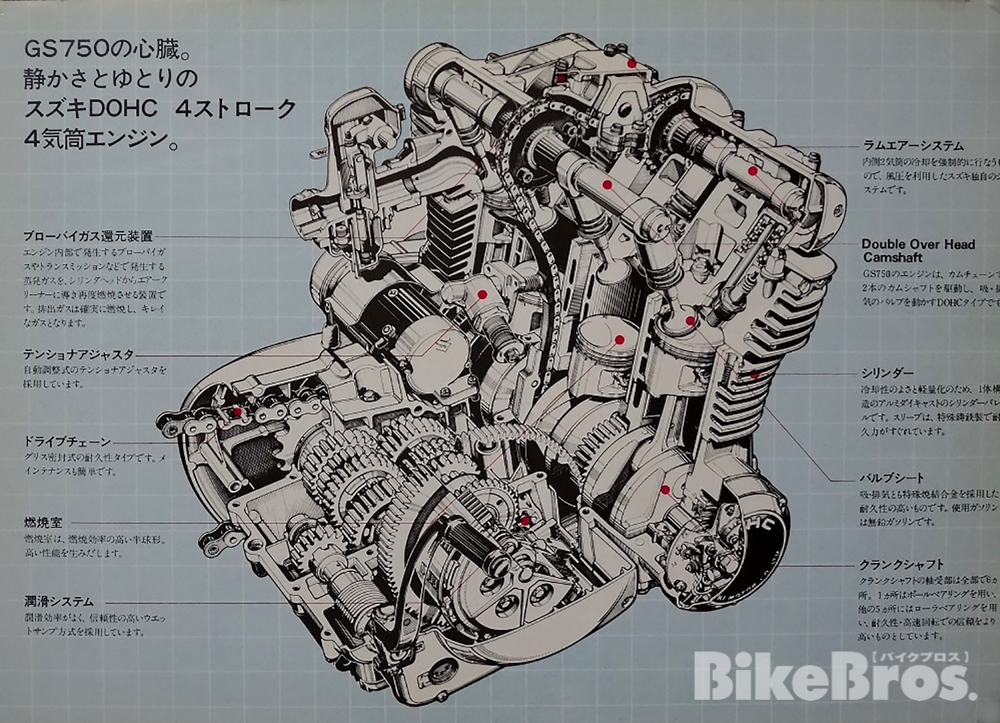
A single drawing published on Cycle magazine as a part of Suzuki’s teaser campaign had forever changed the course of Yoshimura history. The Suzuki GS750 was carefully developed through a thorough analysis of existing 4-stroke 4-cylinder motorcycles and under rigorous testing including a 100-hour (20,000km) full-throttle endurance test of the engine. Shown here is an engine cutaway drawing found in the GS750 Japanese market brochure.
In August, Yoshimura R&D received a phone call from U.S. Suzuki Motor Corp asking for a meeting with the Director of Suzuki’s Motorcycle Design Department Etsuo Yokouchi who was at that moment visiting the States. Yokouchi was the Project Manager for the GS750 and had been involved in the engine development for Suzuki production vehicles before becoming in charge of Suzuki Racer Group in 1974, as well as Suzuki production motorcycle development in 1976.
Yokouchi had been road-testing the GS750 across the U.S. and Europe since February, and then, after a short return to Japan, came back to the U.S. to conduct market research. Yokouchi had been told in advance by the local staff that the renowned 4-stroke engine tuner Pop Yoshimura was interested in GS750. This was a timely proposal for Suzuki, considering their race department were then too preoccupied with their 2-strokers —- especially in road racing (GP500) and motocross (GP and AMA) —- and had almost no experience in tuning 4-stroke production engines. The legendary first encounter between Yokouchi and Pop was realized at the U.S. Suzuki Motor Corp in this accidental time frame. Although their talk lasted only about half an hour, it was enough to reach a mutual agreement.
Etsuo Yokouchi: “Would you like to try the 750?”
Pop Yoshimura: “Sure.”
No contract, just a mutual verbal promise between the two men. They made three agreements:
(1) Yoshimura does the engine tuning.
(2) Suzuki provides the chassis.
(3) The two will always be gentlemen to each other.
They then set an immediate goal of winning a World Championship class race in the 1978 season. The two had never met each other before, but somehow from the beginning, there was a sense of trust between them, perhaps because of what they shared —- both were raised in Kyushu (Yokouchi was from Miyazaki prefecture) and became hands-on engineers.
The GS750 made its first public appearance in October 1976, went on sale the following month and began hitting the local California dealers by the end of the year. However, for a while, Yoshimura R&D could not get hold of a GS750, and it continued to race with the good old Kawasaki Z1’s.
In the early rounds of the 1977 AMA Superbike Championship, Yoshimura R&D team had managed to grab a 2-3 finish in the season-opener by overcoming so many difficulties —- including the workshop fire, the injury of its leader and loss of its bikes —- and took 3rd place in Rd.2, but the victories went to better-handling European twins such as Ducati, Moto Guzzi and BMW. Meanwhile, privateers began to race their GS750’s and GS550’s in production races across the States including the biggest amateur event in California, the AFM Ontario 6-Hour Endurance Race, in which a GS750 (bored out to 845cc) took 7th overall and a GS550 won the 550cc Class. And finally in June, Yoshimura R&D received two GS750’s. Yoshimura Suzuki’s AMA Superbike debut was set to be the Rd.6 on September 11 at Laguna Seca Raceway in California.
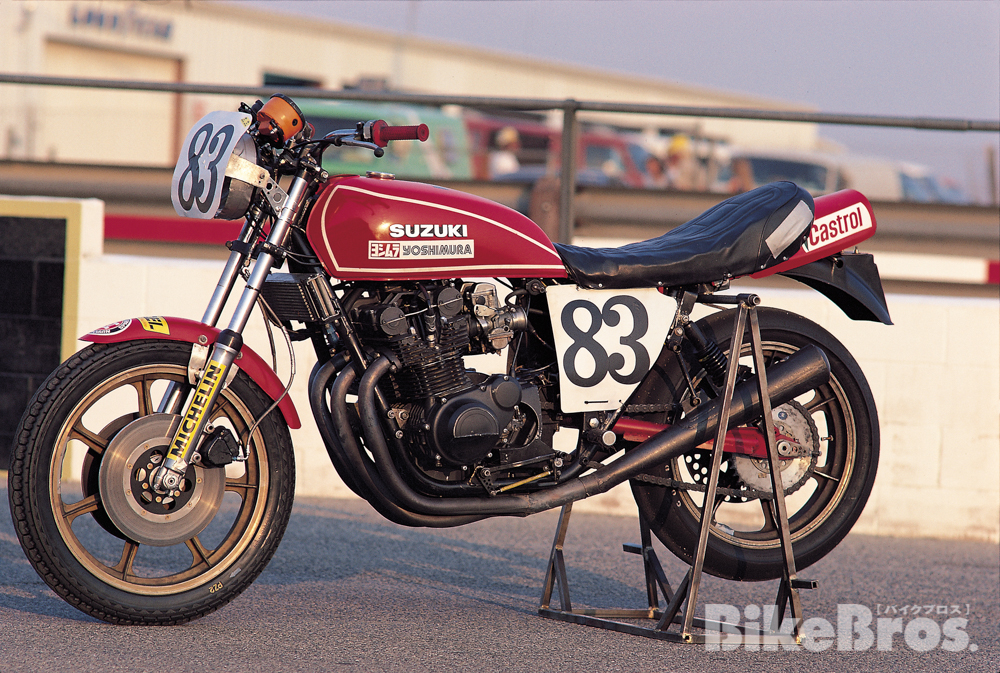
1977 Yoshimura Suzuki GS750/944 AMA Superbike. Following the pre-1977 AMA Rules and Regulations which require all bikes to maintain the looks of their original exhaust pipes, the bike retains its stock muffler shells. Note the laid down rear shocks and sand-cast Morris magnesium wheels (19-inch front and 18-inch rear). As with the other four-cylinder production racers of the era, it runs a treaded race tire (Michelin PZ2) on the front and a full-slick (Goodyear) on the rear. The canted generator cover increases the lean angle (the modification requires the use of internal type rotor as the stock rotor is too large in diameter).
There were tons of works to be done to make a Superbike racer out of the GS750. Working with the 1000cc displacement limit and within the rule to maintain the stock stroke, the engine (originally with a bore x stroke of 65mm x 56.4mm) was bored out to 944cc using 73mm pistons which Moriwaki Engineering fabricated from the cast piston kit for Honda Civic racecar. High-lift camshafts were made from blank cams. Countless hours were spent for head porting as well as to reduce mechanical friction losses.
Suzuki, as Yokouchi promised, had already integrated the cutting-edge racing technology —- developed from their Grand Prix race experience —- and factory race parts into the chassis. It came with sets of KYB gas shocks which were specially modified from the ones used for Suzuki RG500 racer.
“You could adjust the rebound damping by turning the damper rod (6 clicks). Also, unlike the stock shocks, the adjustment of the initial spring tension was done by clips instead of preload cams. And they were combining two springs with different rates (dual-rate springs). I was amazed with the tech they used in GP races,” Fujio recalls.
The inverted gas-shocks back then were only available for factory racers and some motocross bikes. Besides of possessing much better damping characteristics than the conventional upright shocks, they also reduce the risk of oil foaming and fade for consistent performance, thanks to the pressurized nitrogen gas sealed in dampers.
Yoshimura R&D took the chassis apart, reinforced the stock swingarm and suspended it with these gas shocks. Reflecting Suzuki’s experience with motocross bikes —- for which the technology was developed —- and RG500’s, Yoshimura welded the upper shock mounts in a quite radical laid-down layout to give the rear suspension more travel and better road compliance (they also did the same to their own Kawasaki Z1’s). The modified suspension design featured a leverage ratio almost as ideal as that of the linked monoshock suspension of the following decades.
The front forks and triple trees —- looked stock but actually —- were also factory race parts. Forks were the archetype of air forks with an air valve on each top cap, billet bottoms and 36mm diameter tubes (while the stock ones were 35mm). The triple trees were, despite their hand sanded edges, also billet.
Thus, the Yoshimura Suzuki was born, incorporating Suzuki’s GP chassis technology, the cutting-edge 4-stroke 4-cylinder engine and Yoshimura’s tuning technology. The GS750/944 was ready to take the Superbike race to the next level.
On August 7th, a month prior to its AMA debut, the Yoshimura Suzuki GS750/944 ridden by Steve McLaughlin showed up for a local AFM race at Ontario Motor Speedway, alongside the Yoshimura Kawasaki Z1 ridden by Wes Cooley, to enter in the Open Superstreet class which was more open to modifications compared to the AMA Superbike. At the race, McLaughlin retired with machine trouble while Cooley took the victory, however, the GS750/944 proved its potential by lapping as fast as the leading Yamaha TZ750 2-stroke racer in the GP Open class.
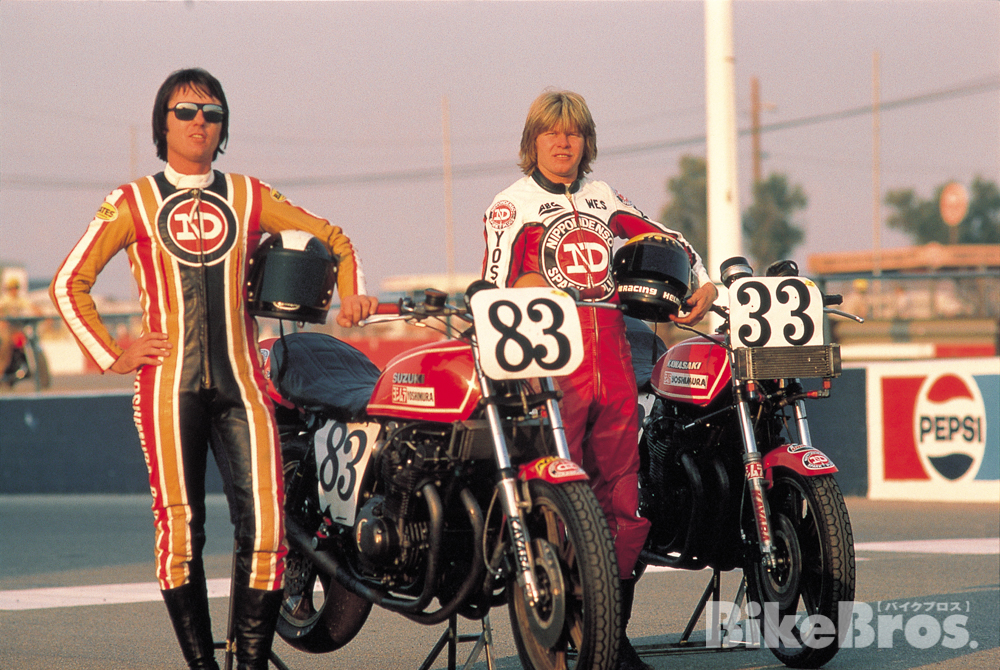
Two superheroes take in the epic Riverside sunset closing out the 1977 AMA Superbike season. In its Grand Final (Rd.7), Cooley (at right) raced the Yoshimura Kawasaki Z1 to a win, following the win of McLaughlin (at left) riding the Yoshimura Suzuki GS750/944 in the Rd.6 at Laguna Seca. Their victories were overwhelming as both tracks were known to be tricky even for their most intense competitor, the great handling Ducati 750SS.
Yoshimura Suzuki GS750/944 made its AMA Superbike debut on September 11 in Rd.6 at the Laguna Seca Raceway, which has been known to be a very tricky low-to-middle-speed mountain course —- uphill first half and downhill second where front-end stiffness matters the most —- featuring the famous “corkscrew” corner, but in reality is a high-speed cornering track with almost no straight sections. The raceway demands the bikes to be set up with the right balance of power and handling; and the riders to have skills, predictions and a boldness to dive into blind corners.>
From the 5th to the 20th lap (of a total of 20), the GS750/944 ridden by McLaughlin and the then 905cc “California Hot Rod” Ducati 750SS ridden by Cook Neilson went head-to-head against each other. As the race progressed the GS750/944 began to leak oil from its generator cover which was canted to achieve a deeper left side lean angle —- modification was possible by replacing the rotor to an internal type (made by Kokusan Denki, provided by Suzuki) in conjunction with a CDI conversion —- perhaps because at that time, Laguna Seca was a 3.058km counterclockwise track with mainly left turns, and there was no infield section. But at the end of the round, the GS750/944 made history with its debut win.
Steve McLaughlin: “This is the most powerful 4-cylinder bike.”
Indeed, and to be exact, it was the first great handling 4-cylinder motorcycle with the most powerful motorcycle production engine at that moment. In this round, McLaughlin set a course record by completing 20 laps in 20:09:18 with an average speed of 90.645mph (the best average speed of the season was 100.982mph). Then in the next, final round (Rd.7 on October 1st), McLaughlin aboard the GS750/944 was forced to retire mid-race due to engine trouble, while Wes Cooley, who had to retire in Rd.6 due to chain failure, grabbed his first AMA victory on Yoshimura Kawasaki Z1 in a near photo-finish battle against Neilson. The joy of victory was so overwhelming for both Cooley and Yoshimura R&D.
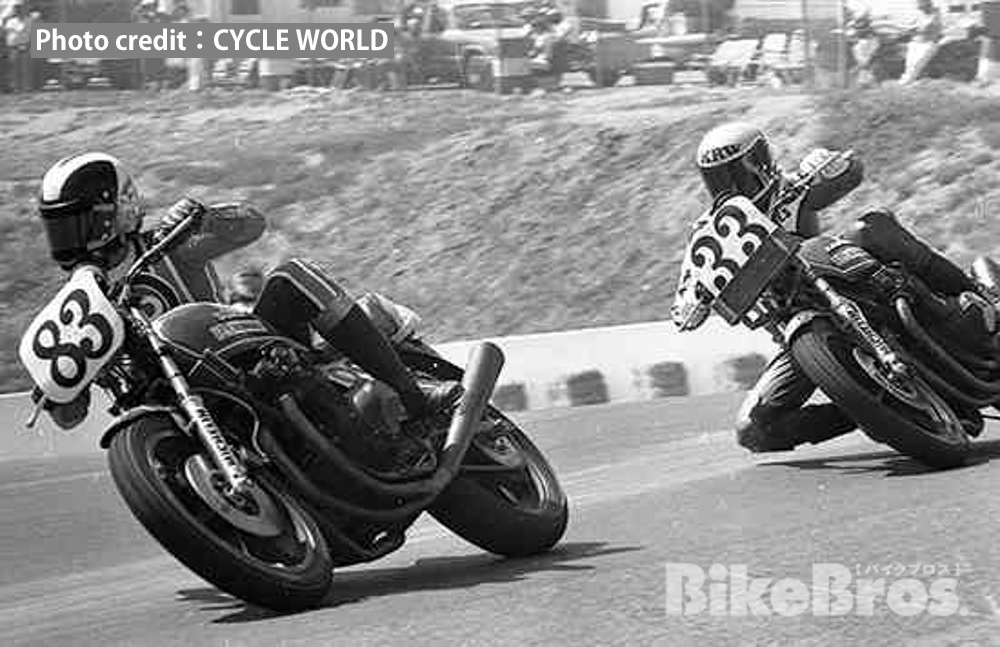
An extremely rare shot of the two Yoshimura superbikes leading the 1977 AMA Superbike Grand Final at Riverside International Raceway (California). Cooley aboard #33 Z1 won the round while McLaughlin aboard #83 GS750/944 had to retire from the round right after this photo was taken. Note the stock muffler shells.
The AMA Superbike racing was taken to the next level. From the 1978 season on, 4-into-1 exhausts were permitted to be used as Yoshimura had been hoping. Suzuki, on the other hand, released their flagship GS1000.
============================================================
Published on July 1, 2020
Stories and photos supplied by Yoshimura Japan / Road Rider Archives / Shigeo Kibiki
Written by Tomoya Ishibashi
Edited by Bike Bros Magazines
[ Japanese Page ]
